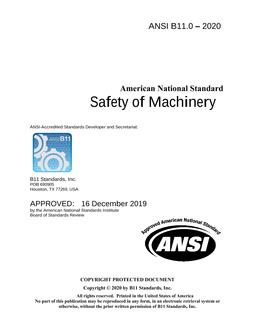
Click here to purchase
This type-A standard applies to new, existing, modified or rebuilt power driven machines, not portable by hand while working, that are used to process materials by cutting; forming; pressure; electrical, thermal or optical techniques; lamination; or a combination of these processes. This includes associated equipment used to transfer material or tooling, including fixtures, to assemble/disassemble, and to inspect or test. The associated equipment, including logic controller(s) and associated software or logic together with the machine actuators and sensors, are considered a part of the industrial machinery.
This can be a single machine or a machinery system(s).
Informative Note 1: As used in this standard, a machine can be an assembly of linked parts or components (at least one of which moves) with the appropriate actuators, control and power circuits, etc., that are joined together for a specific application such as, for the processing, treatment, marking, or moving of material.
Informative Note 2: To improve readability, the terms “machine,” “machinery,” “machine tool” or “machinery system(s)” are used interchangeably throughout the document, either in singular or plural form.
Informative Note 3: A machine system is a systematic array of one or more industrial machines that is not portable by hand while working and includes any associated material handling, manipulating, gauging, measuring, or inspecting equipment.
Informative Note 4: See ANSI B11.20 for additional information on the integration of machinery into a system.
This standard specifies basic terminology, principles and a methodology for achieving acceptable risk in the design and the use of machinery. It specifies principles of risk assessment and risk reduction to help designers, integrators and users of machinery in achieving this objective. These principles are based on knowledge and experience of the design, use, incidents, accidents and risks associated with machinery. Procedures are described for identifying hazards and estimating and evaluating risks during relevant phases of the machine life cycle, and for the elimination of hazards or the provision of sufficient risk reduction. Guidance is given regarding the documentation and verification of the risk assessment and risk reduction process.
Other industry sectors may benefit from applying this standard. A risk assessment may be required to determine if a machine-specific “base” (type-C) safety standard adequately covers the hazards associated with the specific application of a machine.
Where a machine-specific (type-C) safety standard exists, the requirements of the machine-specific “base” (type-C) safety standard shall generally apply. Deviations from the requirements of this standard or from any machine-specific (type-C) safety standard shall be based on a documented risk assessment.
Informative Note 1: See clause 6 for additional information on risk assessment.
Informative Note 2: See 7.17 for a list of example machines covered by other specific standards.
Product Details
- Published:
- 12/16/2019
- ANSI:
- ANSI Approved
- Number of Pages:
- 131
- File Size:
- 1 file , 3.5 MB